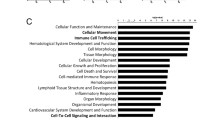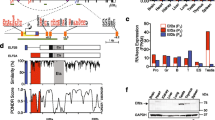Abstract
TFAR19 is a novel apoptosis-related gene and can accelerate cell apoptosis in the presence of apoptosis inducements. Here, we studied the effects of TFAR19 on some biophysical properties of mouse erythroleukemia (MEL) cells and their molecular and structural basis. After transfected with TFAR19 and apoptosis, inducement, MEL revealed a high cell membrane fluidity, a decrease in resynthesis of phospholipids, an increase in the proteins/nucleic acids ratio, a relatively orderly cytoskeleton network, an impaired deformability, a low integrin aM expression, and a decrease in adhesion to endothelial cells. These findings suggest the potential of TFAR19 for antitumor cell migration, and thus for antitumor gene therapy.
Similar content being viewed by others
References
Earnshaw, W. C., Martins, L. M., and Kaufmann, S. H. (1999) Mammalian caspases: structure, activation, substrates, and functions during apoptosis. Annu. Rev. Biochem. 68, 383–424.
Meier, P., Finch, A., and Evan, G. (2000) Apoptosis in development. Nature 407, 796–801.
Yuan, J. and Yankner, B. A. (2000) Apoptosis in the nervous system. Nature 407, 802–809.
Thompson, C. B. (1995) Apoptosis in the pathogenesis and treatment of disease. Science 267, 1456–1462.
Evan, G. and Littlewood, T. (1998) A matter of life and cell death. Science 281, 1317–1322.
Liu, H., Wang, Y., Zhang, Y., et al. (1999) TFAR19, a novel apopotosis-related gene cloned from human leukemia cell line TF-1, could enhance apoptosis of some tumor cells induced by growth factor withdrawal. Biochem. Biophys. Res. Commun. 254, 203–210.
Chen, Y. Y., Sun, R. H., Han, W., et al. (2001) Nuclear translocation of PDCD5 (TFAR19): an early signal for apoptosis? FEBS Lett. 509, 191–196.
Jiao, J. F., Chen, G. Y., Huang, M., et al. L. (2000) Effect of rhTFAR19 protein on MCF-7 cell cycle and apoptosis induced by 1 rays. Chin. J. Oncol. 22, 102–104.
Li, H. P., Cao, Z. M., Shao, Y. X., Sun, W., and Jia, T. Z. (2000) Effect of rhTFAR19 protein on cell apoptosis of 7721 liver cancer cells induced by hydroxy camptothecin. J. Clin. J. Immunol. 32, 408–410.
Zhang, Y. M., Xu, X. Z., Liu, H. T., Song, Q. S., and Ma, D. L. (2000) The apoptosis-accelerating effect of human recombinant TFAR19 protein on leukemia HL-60 cells. Chin. J. Immunol. 16, 8–11.
Wang, Y., Li, X. T., Wang, L., et al. (2004) An alternative form of paraptosis-like cell death, triggered by TAJ/TROY and enhanced by PDCD5 overexpression. J. Cell Sci. 117, 1525–1532.
Chien, S. and Sung, K. L. P. (1984) Effect of colchicines on viscoelastic properties of neutrophils. Biophys. J. 46, 383–386.
Gu, L., Yao, W. J., Yan, Z. Y., et al. (2003) Effect of TFAR19 gene on the growth and biophysical properties of mouse erythroleukemia cell line MEL. Sci. China (Series C) 46, 293–301.
Azumi, T. and McGlynn, S. P. (1962) Polarization of the luminescence of phenanthrene. J. Chem. Phys. 37, 2413–2420.
Yao, W. J., Gu, L., Sun, D. G., Ka, W. B., Wen, Z. Y., and Chien, S. (2003) Wild type p53 gene causes reorganization of cytoskeleton and, therefore, the impaired deformability and difficult migration of murine erythroleukemia cells. Cell Motil. Cytoskeleton 56, 1–12.
Sung, K. L. P., Sung, L. A., Crimmins, M., Burakoff, S. J., and Chien, S. (1988) Dynamic changes in viscoelastic properties in cytotoxic T-lymphocyte-mediated killing. J. Cell. Sci. 91, 179–189.
Schmid-Schönbein, G. W., Sung, K. L. P., Tözeren, H., Skalak, R., and Chien, S. (1981) Passive mechanical properties of human leukocytes. Biophys. J. 36, 243–256.
Yao, W. J., Wen, Z. Y., Yan, Z. Y., et al. (2001) Low viscosity ektacytometry and its validation tested by flow chamber. J. Biomech. 34, 1501–1509.
Liu, K. Z., Schultz, C. P., Mohammad, R. M., Al-Katib, A. M., Johnston, J. B., and Mantsch, H. H. (1998) Similarities between the sensitivity to 2-chlorodeoxyadenosine of lymphocytes from CLL patients and bryostain 1-treated WSUCLL cells: an infrared spectroscopic study. Cancer Lett. 127, 185–193.
Gao, T. Y., Ci, Y. X., and Jian, H. Y. (2000) FTIR investigation of the interaction of tumor cells treated with caffeic acid and chlorogenic acid. Vibrational Spectrosc. 24, 225–231.
Le, G. J. M., Moriani, H., Fardel, O., Guillouzo, A., and Manfait, M. (1994) Conformational changes in membrane proteins of multidrug-resistant K562 and primary rat hepatocyte cultures as studied by Fourier transform infrared spectroscopy. Anticancer Res. 14, 1541–1548.
Bevers, E. M., Comfurius, P., Dekkers, D. W., Harmsma, M., and Zwaal, R. F. (1998) Regulatory mechanisms of transmembrane phospholipid distributions and pathophysiological implications of transbilayer lipid scrambling. Lupus, 7, s126-s131.
Vernier, P. T., Sun, Y., Marcu, L., Salemi, S., Craft, C. M., and Gundersen, M. A. (2003) Calcium bursts induced by nanosecond electric pulses. Biochem. Biophys. Res. Commun. 310, 286–295.
Nathan, I., Ben-Valid, I., Henzel, R., et al. (1998) Alterations in membrane lipid dynamics of leukemic cells undergoing growth arrest and differentiation: dependency on the including agent. Exp. Cell. Res. 239, 442–446.
Ramesh, J., Salman, A., Hammody, Z., et al. (2001) Application of FTIR microscopy for the characterization of malignancy: H-ras transfected murine fibroblasts as an example. J. Biochem. Biophys. Methods 50, 33–42.
Wright, M. M. and McMaster, C. R. (2002) Phospholipid synthesis, diacylglycerol compartmentation, and apoptosis. Biol. Res. 35, 223–229.
Musashi, M., Ota, S., and Shiroshita, N. (2000) The role of protein kinase C isoforms in cell proliferation and apoptosis. Int. J. Hematol. 72, 12–19.
Wu, Z. Z., Zhang, G., Long, M., Wang, H. B., Song, G. B., and Cai, S. X. (2000) Comparison of the viscoelastic properties of normal hepatocytes and hepatocellular carcinoma cells under cytoskeletal perturbation. Biorheology 37, 279–290.
Edelman, J. M., Dimilla, P. A., and Abbelda, S. M. (1995) Principles of Cell Adhesion. CRC Press, London.
Goldstein, A. S. and DiMilla, P. A. (2002) Effect of adsorbed fibronectin concentration on cell adhesion and deformation under shear on hydrophobic surfaces. J. Biomed. Mater. Res. 59, 665–675.
Olivier, L. A. and Truskey, G. A. (1993) A numerical analysis of forces exerted by laminar flow on spreading cells in a parallel plate flow chamber assay. Biotechnol. Bioeng. 42, 963–973.
Dong, C., Cao, J., Struble, E. J., and Lipowsky, H. H. (1999) Mechanics of leukocyte deformation and adhesion to endothelium in shear flow. Ann. Biomed. Eng. 27, 298–312.
Author information
Authors and Affiliations
Corresponding author
Additional information
Contributed equally to this work.
Rights and permissions
About this article
Cite this article
Gu, L., Jiang, Y., Wang, Y. et al. TFAR19 gene changes the biophysical properties of murine erythroleukemia cells. Cell Biochem Biophys 43, 355–363 (2005). https://doi.org/10.1385/CBB:43:3:355
Issue Date:
DOI: https://doi.org/10.1385/CBB:43:3:355




